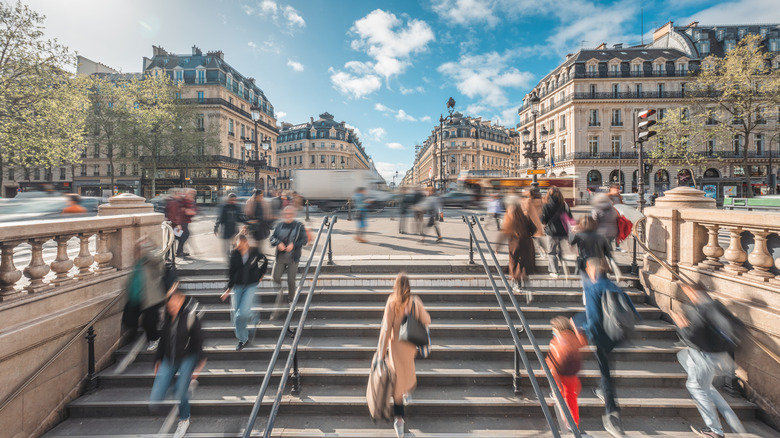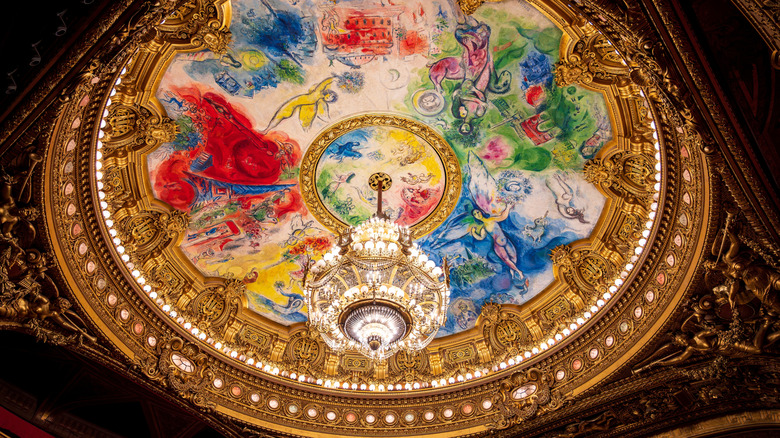The French Consider This Often-Overlooked Paris Landmark Just As Quintessential As The Eiffel Tower
Packed with world-class museums, gastronomic restaurants, and charming cobblestone streets for one to indulge in the art of aimless strolling (or flânerie, as the French call it), it comes as no surprise that Paris ranked first in Euromonitor International's top city destinations of 2024. As someone who's lived in Paris on and off for over 20 years, I've played tour guide to visiting family and friends more times than I can count. While I understand that the Eiffel Tower, the Louvre, or the overcrowded Champs-Élysées are non-negotiables for a first-timer in Paris, I feel duty-bound to introduce my guests to often-overlooked landmarks that are quintessentially Parisian. Along with recommending Rick Steves' secret Louvre entrance with fewer lines and warning them about the city's rampant pickpocketing problem, I wholeheartedly encourage visitors to marvel at a stunningly underrated artwork that's hiding in plain sight: Marc Chagall's dreamy and colorful ceiling painting at the Opéra Garnier.
Unveiled to the public in 1964, Chagall's artwork dominates Opéra Garnier's ceiling. Drawing inspiration from music, poetry, and theater, Chagall interpreted the works of 14 lyrical and opera composers on a 2,400-square-foot canvas, which was installed 7 inches below the dome's original painting, leaving artist Jules-Eugène Lenepveu's 1872 artwork underneath fully intact. Chagall's painting elicited controversy not only for the aesthetic clash between modern artwork and classic architecture but also because of Chagall's Russian and Jewish origins. Over the years, the contemporary painting became a refreshing and fashionable addition to the classic silhouette of Opéra Garnier. Just like the arrival of Daniel Buren's columns in the Palais-Royal in 1986 and I.M. Pei's pyramid at the Louvre in 1989, Chagall's ceiling was ahead of its time.
The details behind Chagall's controversial painting
France's then Minister of Culture André Malraux approached Marc Chagall with the proposition of creating a new painting for Opéra Garnier's ceiling in 1960, with the aim of revitalizing the Opéra's conservative look. The idea to replace the ceiling's existing painting — a classical-style artwork by artist Jules-Eugène Lenepveu — was as audacious as they come, but the commission was officially approved soon after. Chagall, then in his late 70s, painted on 12 monumental canvas panels and a round central one with the help of his assistants Roland Bierge, Paul Versteeg, and Jules Paschal. The painting depicts Hector Berlioz's "Romeo and Juliet," Georges Bizet's "Carmen," Wolfgang Amadeus Mozart's "Magic Flute," Richard Wagner's "Tristan and Isolde," and Igor Stravinsky's "The Firebird," among others. Interspersed with appearances of Parisian monuments (the Eiffel Tower, Arc de Triomphe, and Place de la Concorde) and a smattering of Chagall's recurring iconographies, the artist's imagery flows loosely across the canvas in bold, vivid colors.
Chagall worked on the painting at the Musée des Gobelins before it was moved to a workshop in Meudon, now known as the cultural and exhibition center Hangar Y, for mounting and framing. The entire project was carried out in secretive conditions to ward off public and press scrutiny. Versteeg recalled armed guards being posted outside the workshop as they carried out their work. Finally, it was inaugurated on September 23, 1964. Chagall bequeathed the painting to his adopted country and never asked for monetary compensation for the painting, though the imaging rights to the artwork remained in his name.
Visiting Chagall's ceiling and the rest of Opéra Garnier
To this day, people are still calling for the ceiling artwork — which turned 60 years old in 2024 — to be removed, and for Jules-Eugène Lenepveu's work to be reinstated. Debate still hounds the painting. "I generally like Chagall, but his work is suited more for the smaller scale paintings, where his detailing is more intimate and can be appreciated," Redditor u/Strydwolf comments. For u/jeredendonnar, it's a "better late than never" situation: "It is an acquired taste, to be sure, but it is starting to grow on me."
If I've convinced you of adding Opéra Garnier to your Paris itinerary to see Chagall's ceiling (and the rest of the fantastic building), I'd recommend checking the official website first, as the auditorium is often subject to full or partial closure due to theater practices or private activities. Opéra Garnier is located in Paris's 9th arrondissement, a stone's throw from Boulevard Haussmann's Galeries Lafayette and La Madeleine, and close to some of the most luxurious hotels in Paris. I'd pass on a taxi; in fact, you may want to completely avoid taxis in Paris as a tourist due to congested roads and exorbitant taxi rates. Metros 3, 7, and 8 will get you to the Opéra station in no time, as well as the RER A (Auber station). Entry is via the Scribe-Auber street corner from 10 a.m. to 4 p.m. A self-guided tour ticket costs €15 as of this writing. Aside from Marc Chagall's ceiling, be prepared for opulence as you climb the majestic staircase or drop by the ornate Grand Salon.


